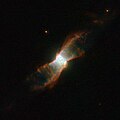Податотека:NGC 6881 HST.jpg
NGC_6881_HST.jpg (532 × 532 пиксели, големина: 129 КБ, MIME-тип: image/jpeg)
Историја на податотеката
Стиснете на датум/време за да ја видите податотеката како изгледала тогаш.
| Датум/време | Минијатура | Димензии | Корисник | Коментар | |
|---|---|---|---|---|---|
| тековна | 11:13, 31 декември 2019 |  | 532 × 532 (129 КБ) | BevinKacon | actual size from source |
| 14:18, 12 март 2012 |  | 1.280 × 1.280 (266 КБ) | Jmencisom |
Употреба на податотеката
Податотекава се користи во следнава страница:
Глобална употреба на податотеката
Оваа податотека ја користат и следниве викија:
- Употреба на ar.wikipedia.org
- Употреба на az.wikipedia.org
- Употреба на beta.wikiversity.org
- Употреба на be.wikipedia.org
- Употреба на bs.wikipedia.org
- Употреба на ce.wikipedia.org
- Употреба на de.wikipedia.org
- Употреба на diq.wikipedia.org
- Употреба на en.wikipedia.org
- Употреба на en.wikiversity.org
- Употреба на eo.wikipedia.org
- Употреба на eu.wikipedia.org
- Употреба на fa.wikipedia.org
- Употреба на fr.wikipedia.org
- Употреба на hr.wikipedia.org
- Употреба на kk.wikipedia.org
- Употреба на lb.wikipedia.org
- Употреба на my.wikipedia.org
- Употреба на nl.wikipedia.org
- Употреба на pl.wikipedia.org
- Употреба на pt.wikipedia.org
- Употреба на ru.wikipedia.org
- Употреба на sk.wikipedia.org
- Употреба на sr.wikipedia.org
- Употреба на tr.wikipedia.org
- Употреба на tt.wikipedia.org
- Употреба на uk.wikipedia.org
- Употреба на uz.wikipedia.org
- Употреба на www.wikidata.org

